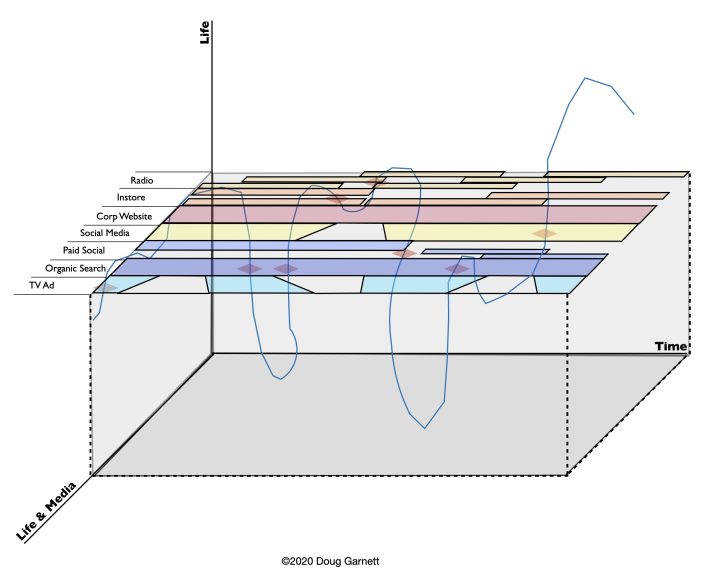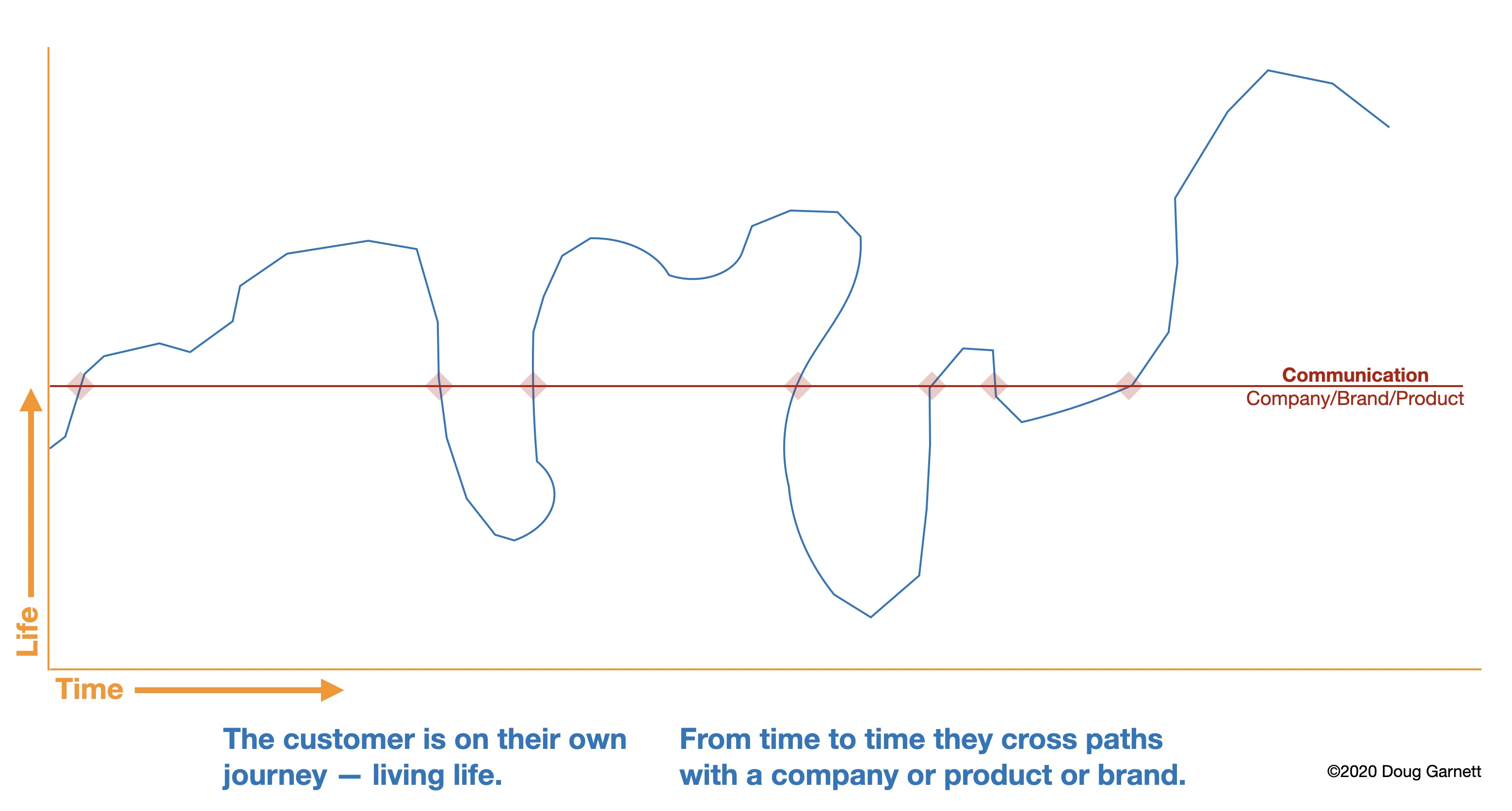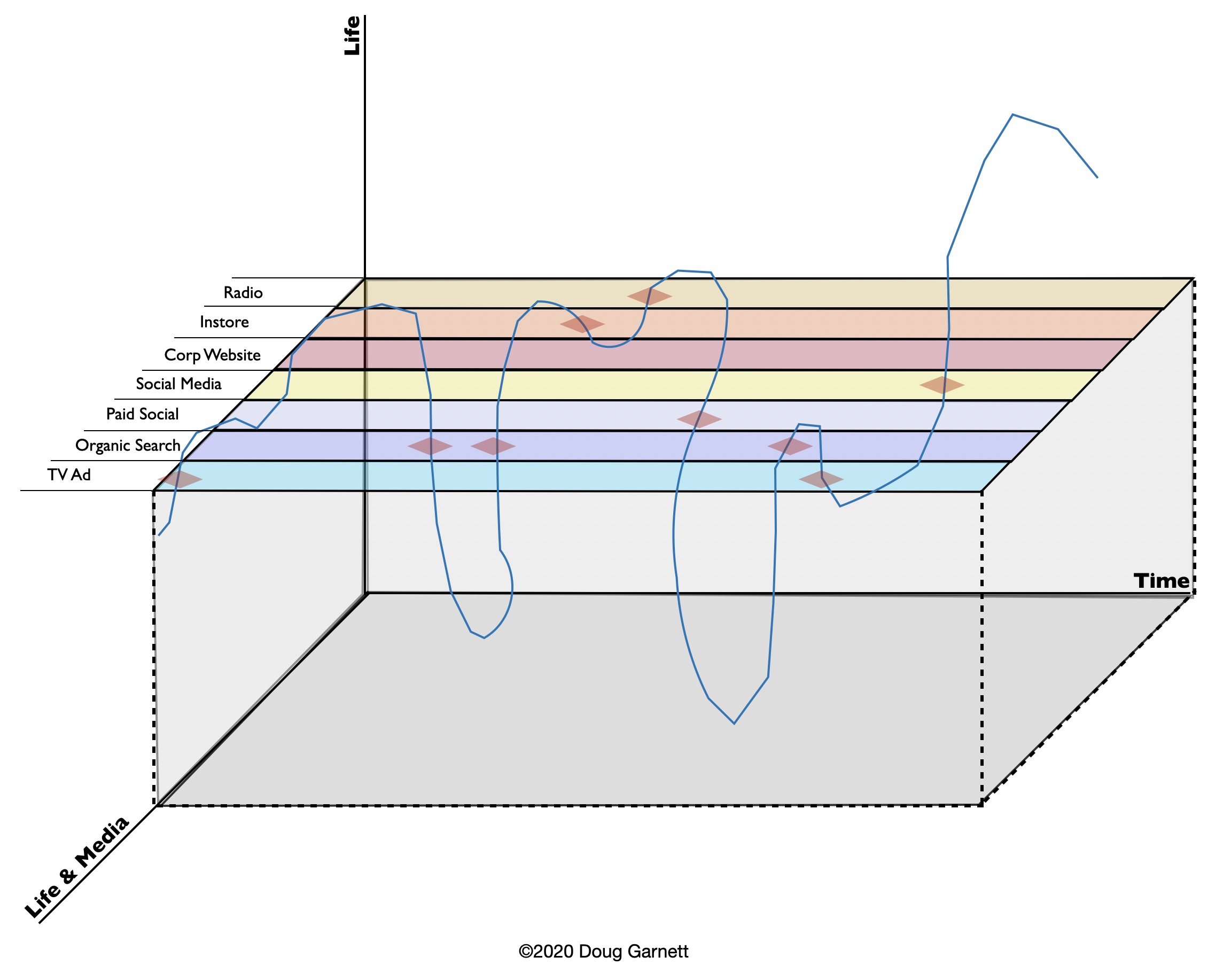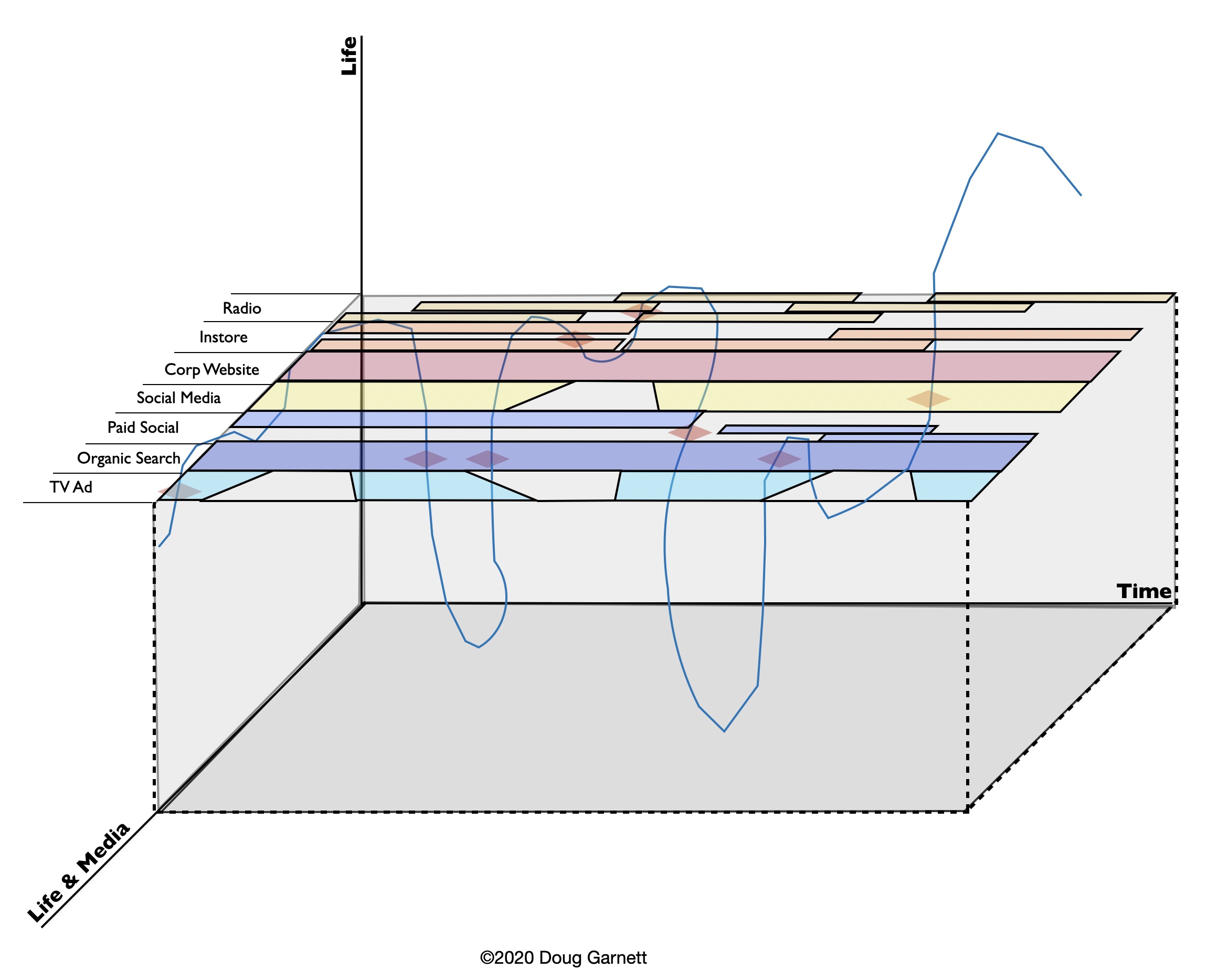
The Customer’s Journey Isn’t About You

The online and corporate communication worlds have embraced an idea that there is a “customer journey” which can be driven and guided by communication. Unfortunately, while customers ARE on a journey, it is not about you. And that makes all the difference.
The Illusion of the Precise in “Customer Journey” Maps
Maps are wonderful things — they’re useful because they idealize territory in order to help us get from one point to another. Which is, of course why we ALWAYS need to remember the key operative truth:
The Map is NOT the Territory
I have no problem dropping out real world detail in order to simplify a territory to create ways to take action in that territory. That said, we need to never forget that we have dropped out detail — and sometimes those details matter.
In the worst cases, detail is dropped out yet the map is created to imply an illusion of preciseness. Here is one example of a “Customer Journey” map which I found at Bright Vessel:
Oof. This map isn’t about understanding a customer’s journey. The map implies an incredibly precise planning which has no connection to the real — yet where each department is involved along the “journey”. I suppose we can forgive Bright Vessel — nothing sells better to companies than a false perception of “being in control.” It’s no wonder they landed here.
A More Accurate Map of the Customer’s Journey: Starting in 2D
The above map isn’t about customers but about shepherding company resources — there’s almost no “customer” to be found in the map but there sure are a lot of departments who can prevent effective communication. Let’s look at a different map which focuses more on the customer journey. While each consumer has an entirely different shape of path, here’s a reasonable example.
 Note how little time any individual customer spends around a “touchpoint” where your company can affect them. Also note that there is a large “accidental” component in those contacts. The accidental component suggests why media planning is not about “placing” the contact with laser-like accuracy — but in setting up communications for good “accidents” which lead to profit.
Note how little time any individual customer spends around a “touchpoint” where your company can affect them. Also note that there is a large “accidental” component in those contacts. The accidental component suggests why media planning is not about “placing” the contact with laser-like accuracy — but in setting up communications for good “accidents” which lead to profit.
This image got me thinking and excited. But I also realized there is a weakness in this image: It still implies the company contacts with customers can be thought of in order. They can’t.
The 3D Map: Random Interactions with Communication
It struck me that your company doesn’t offer communication on a line — they happen with depth. In other words, there are parallel efforts where consumers might cross paths with your communication. So the places your customers might encounter and remember your communications looks far more like this:
 An individual consumer encounters different elements of your company, brand, product, and communication in sporadic and random ways — no matter how carefully you might “plan” for a linear journey. And each individual consumer encounters (a) a different random collection of your communication and (b) encounters that communication in a different random order.
An individual consumer encounters different elements of your company, brand, product, and communication in sporadic and random ways — no matter how carefully you might “plan” for a linear journey. And each individual consumer encounters (a) a different random collection of your communication and (b) encounters that communication in a different random order.
A 3D Map With Communication Campaign Realities
After reading this initial post, Shahin Khan recommended a thought which I now add. Namely, the above illustration implies that each area of communication is “always there”. That’s never the case. Let me suggest the following: Even when someone passes a point where they MIGHT encounter your communication, often the communication isn’t there.
After all, it’s expensive to blanket high levels of non-stop media. A TV campaign only airs in certain commercial breaks on certain channels. Your social media work is periodic — and scrolls off the screen quite quickly. In this chart, I let organic search and your website be present at all times — but nothing else.
Important research noted by Byron Sharp indicates a constant low level of advertising spending is more effective than concentrating that spend in a few very intensive flights of limited length. This makes sense in looking at this final map:
A Few Lessons We Need to Learn
I don’t know yet all that this map implies but am hoping other marketers find it interesting and thought provoking. That said, here are a few brief observations:
- Tiny bits of time: Consumers spend only the tiniest bits of time with your product or your communication. The communication you’re putting out heavily consumes your attention. But that same communication is only a minuscule part of a consumer’s life. Out of almost 9,000 hours in the year, the customer journey crosses paths with you for perhaps an entire 10-20 minutes…if you’re lucky.
- Learning is not linear. Consumers learn in bits and pieces — like humans seem to learn everything. Any communication planning which ignores this truth can only succeed accidentally.
- The advertising residual is more important than the advertising. In my planning work, I focus heavily on the “advertising residual” — that which is left behind after the communication disappears. These illustrations shows you need to focus on making a random set of encounters leave behind a coherent collection of residuals. That collection of residuals lead to brand value, product value, purchase, and long term consumption.
- Which encounters are remembered? The consumer mind will, in fact, ignore many of the random interactions when the consumer’s mind doesn’t rank them as important enough for the cost of the attention they’d need. This does make it possible that the encounters are perceived by consumers as less than random as they create their own perception of what they’ve seen. (This is, by the way, more reason never to trust consumer recall of time dependent encounters.)
- The value of long forms in advertising. In direct marketing, the long letter has generally been most effective & the 30-minute infomercial has sold huge amounts of product. In both these disciplines, once an effective creative is found it tends to work for years and years. That all makes sense with this sense of consumer journey. Both forms take advantage of a single (or small number) consumer encounter to deliver full, persuasive messages. This eliminates some need for future beneficial accidents. For the right product in the right situation, no wonder they are an effective option.
- This has media implications. Given that these contacts have randomness and accident, how should we change how we view media? This is an important question for which I don’t have an answer but we already know its critical.
- For the consumer, there’s no funnel. It’s no wonder that so much “funnel” planning has failed to create long term impact. The consumer isn’t encountering things as a funnel. This doesn’t mean considering communications around the funnel is unimportant. A funnel model can help us study all the range of communication which might be needed — so it’s a good thing to study in order to identify where our work is weak or strong. But don’t apply it to the consumer — it’s only a map for studying the potential of all communication.
Let Exploration Continue
In presenting this outline, I hope many will give up attempts to force communication into tidy boxes of linear persuasion. I am not one who rejects need for persuasion in advertising. but I DO reject the idea that persuasion should be linear. Any good negotiator knows that persuasion is one of the least linear process known to mankind. And the negotiators who fail are those who force it to move in discrete steps.
It’s my hope that a few may find this helps them envision the market in new ways and leads to more effective communication. Now, let’s go sell something — relying on a more human understanding of how people encounter communication.
Note: My wander into this thinking was started through a Twitter conversation with London based planner James Hankins and others responding to his excellent post on the same topic.
©2020 Doug Garnett — All Rights Reserved
Through my company Protonik LLC based in Portland Oregon, I consult with companies on their efforts around new and innovative products and explore what marketers should learn from the field of complexity science. An adjunct instructor are Portland State University, I also teach marketing, consumer behavior, and advertising.
As a specialty, I also advise a select group of clients attempting to bring new life to Shelf Potatoes or taking existing products to new markets. You can read more about these services and my unusual background (math, aerospace, supercomputers, consumer goods & national TV ads) at www.Protonik.net.
Categories: Advertising, Business and Strategy, consumer marketing, marketing, Marketing Research


Posted: May 21, 2020 21:58
Communication Has Been Our Most Effective Weapon for Fighting the Pandemic | Doug Garnett's Blog
Posted: May 22, 2020 18:51
Saved by Communication — More In-depth Discussion | Doug Garnett's Blog
Posted: September 1, 2021 06:06
Why the sales funnel is the cockroach of marketing concepts
Posted: December 3, 2021 18:20
Mô hình phễu mua hàng – Lỗi thời nhưng vì sao vẫn phổ biến? - Top1Brand - T01 - Top1Index.com - Top1Index.vn
Posted: August 24, 2022 20:48
I funnel hanno qualche validità scientifica o sono una sciocchezza? - Deep Marketing Evidence Based Marketing
Posted: August 25, 2022 00:03
Doug Garnett
Posted: September 4, 2022 14:11
Sales Cycle. Marketing Funnel. Customer Journey.